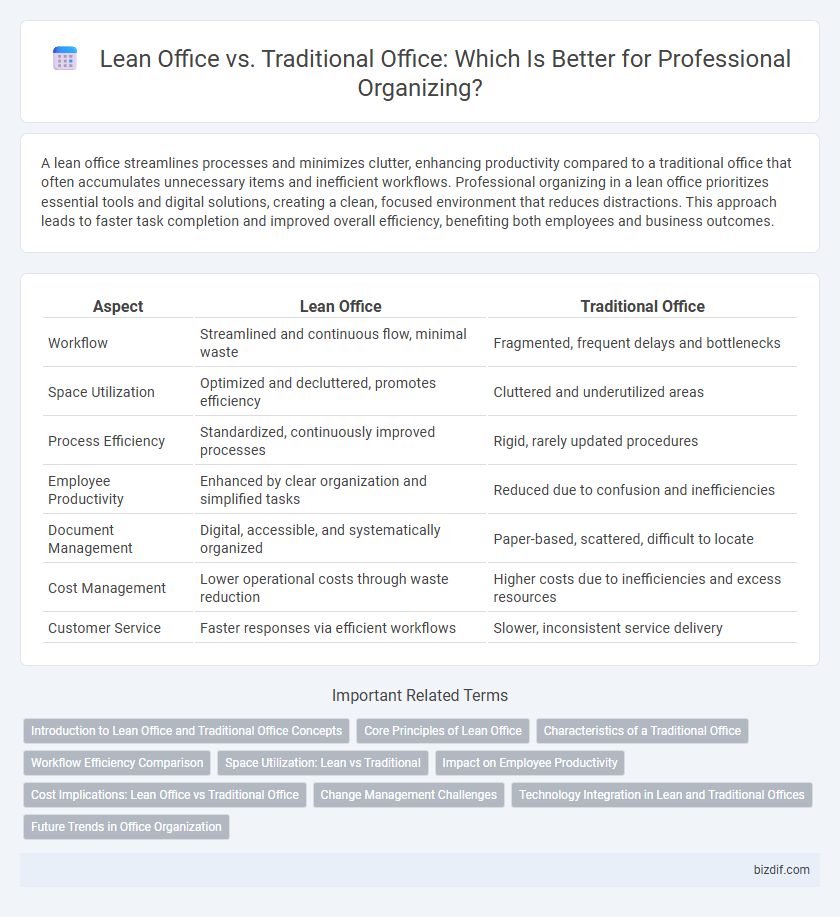A lean office streamlines processes and minimizes clutter, enhancing productivity compared to a traditional office that often accumulates unnecessary items and inefficient workflows. Professional organizing in a lean office prioritizes essential tools and digital solutions, creating a clean, focused environment that reduces distractions. This approach leads to faster task completion and improved overall efficiency, benefiting both employees and business outcomes.
Table of Comparison
| Aspect | Lean Office | Traditional Office |
|---|---|---|
| Workflow | Streamlined and continuous flow, minimal waste | Fragmented, frequent delays and bottlenecks |
| Space Utilization | Optimized and decluttered, promotes efficiency | Cluttered and underutilized areas |
| Process Efficiency | Standardized, continuously improved processes | Rigid, rarely updated procedures |
| Employee Productivity | Enhanced by clear organization and simplified tasks | Reduced due to confusion and inefficiencies |
| Document Management | Digital, accessible, and systematically organized | Paper-based, scattered, difficult to locate |
| Cost Management | Lower operational costs through waste reduction | Higher costs due to inefficiencies and excess resources |
| Customer Service | Faster responses via efficient workflows | Slower, inconsistent service delivery |
Introduction to Lean Office and Traditional Office Concepts
Lean office methodology maximizes efficiency by eliminating waste, streamlining workflows, and fostering continuous improvement in administrative processes. Traditional office setups often feature hierarchical structures, cluttered workspaces, and redundant tasks that hinder productivity. Implementing lean office principles transforms conventional environments into agile, organized spaces that enhance collaboration and reduce operational costs.
Core Principles of Lean Office
Lean office emphasizes eliminating waste, streamlining workflows, and enhancing value by focusing on essential tasks, contrasting with traditional office methods that often tolerate inefficiencies and redundant processes. Core principles of Lean office include continuous improvement (Kaizen), just-in-time information flow, standardized work procedures, and workplace organization using 5S methodology (Sort, Set in order, Shine, Standardize, Sustain). Implementing these principles improves productivity, reduces clutter, and fosters a culture of efficiency in professional organizing.
Characteristics of a Traditional Office
A traditional office is characterized by hierarchical structures, fixed workspaces, and extensive paperwork, often leading to cluttered desks and inefficient use of space. It relies heavily on physical files, face-to-face meetings, and rigid schedules, which can slow down workflows and reduce flexibility. This environment typically emphasizes individual workstations rather than collaborative or open-plan designs seen in lean offices.
Workflow Efficiency Comparison
Lean office environments prioritize streamlined workflows by eliminating waste and promoting just-in-time processes, resulting in faster task completion and reduced idle time. Traditional offices often experience workflow bottlenecks due to excessive paperwork, redundant steps, and unclear task delegation. Studies show lean offices improve employee productivity by up to 30% through optimized space utilization and standardized procedures.
Space Utilization: Lean vs Traditional
Lean office design maximizes space utilization by minimizing clutter and organizing work areas for efficiency, resulting in flexible layouts and reduced wasted square footage. Traditional offices often allocate larger, fixed spaces for individual employees and excessive storage, leading to underutilized areas and inefficient use of office real estate. Efficient space management in lean offices enhances collaboration and adaptability, directly supporting productivity and cost savings.
Impact on Employee Productivity
Lean office environments streamline workflows by minimizing clutter and standardizing processes, directly enhancing employee productivity through reduced distractions and faster task completion. Traditional offices often feature disorganized spaces and inefficient layouts, leading to frequent disruptions and increased time spent searching for materials. Implementing lean principles fosters a focused work atmosphere, improving task efficiency and overall employee performance.
Cost Implications: Lean Office vs Traditional Office
Lean office models reduce overhead costs by minimizing excess inventory, optimizing workspace utilization, and streamlining processes, resulting in lower operational expenses compared to traditional offices. Traditional office setups often incur higher costs due to inefficient resource allocation, excessive paper use, and underutilized space. Implementing lean principles leads to significant savings in supplies, energy, and administrative expenditures.
Change Management Challenges
Lean offices face unique change management challenges compared to traditional offices, as employees must adapt to continuous process improvements and a culture of waste elimination. Resistance often stems from habitual workflows and fear of job redundancy, requiring targeted communication and training strategies. Success depends on leadership commitment and employee involvement to effectively transition to lean methodologies.
Technology Integration in Lean and Traditional Offices
Technology integration in lean offices emphasizes streamlined digital workflows, automation tools, and cloud-based collaboration to minimize physical clutter and enhance operational efficiency. Traditional offices often rely on legacy systems and manual processes, leading to increased paper usage and slower information retrieval. Adopting lean office technology reduces redundancies and supports real-time data access for improved productivity and resource management.
Future Trends in Office Organization
Future trends in office organization emphasize lean office principles, prioritizing streamlined workflows, minimal physical clutter, and digital document management to enhance productivity. Unlike traditional offices burdened with excessive paperwork and inefficient layouts, lean offices utilize flexible workspaces and cloud-based technologies to adapt rapidly to changing business needs. Embracing lean methodologies supports sustainability goals and fosters collaboration through optimized space utilization and real-time resource access.
lean office vs traditional office Infographic

 bizdif.com
bizdif.com